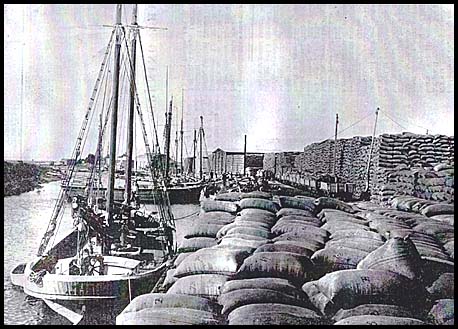Telegraph offices in the Port Wakefield - Salisbury to the Barossa region.
- Home, index, site details
- Australia 1901-1988
- New South Wales
- Overview of NSW
- Telegraph lines
- Telegraph Offices
- Date stamps
- Forms
- Envelopes
- Rates
- Stamps
- Queensland
- Overview of Qld
- Telegraph lines
- Telegraph offices
- Date stamps
- Forms
- Envelopes
- Rates
- Stamps
- South Australia
- Overview of SA
- Telegraph lines
- Telegraph Offices
- Date stamps
- Forms
- Envelopes
- Rates
- Stamps
- Tasmania
- Overview of Tasmania
- General developments
- Reports
- Organisation
- Telegraph lines
- Telegraph Offices
- Date stamps
- Railway lines
- Forms
- Envelopes
- Rates
- Stamps
- Overview of Tasmania
- Victoria
- Overview of Vic.
- Telegraph lines
- Telegraph offices
- Date stamps
- Forms
- Envelopes
- Rates
- Stamps
- Ephemera
- Western Australia
- Overview of WA
- Telegraph lines
- Telegraph Offices
- Date stamps
- Forms
- Envelopes
- Rates
- Stamps
The following Telegraph Offices are included in this page:
| Freeling | Gawler | Hamley Bridge | Kapunda | Mallala | Marrabel | Penfield |
| Port Wakefield | Roseworthy | Salisbury | Smithfield | Stockport | Stockyard Creek | Tarlee |
| Tea Tree Gulley | Two Wells | Virginia | Wasleys |
|
The Telegraph Office was opened in 1861 - just before the onset of a long drought which devastated the area. A Post Office had been opened on 3 December 1860. The Gawler-Kapunda Railway had been constructed in 1860 and Freeling was a stopping point on that line. In 1866, Freeling had a population of 60 people. |
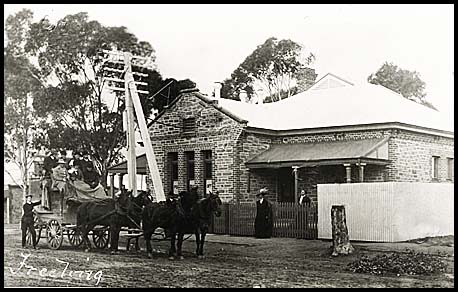 Erecting a telegraph pole outside the Post Office. |
| By May 1909, the Commonwealth Government was planningto build a new Post and Telegraph Office at Freeling. | |
|
GawlerTown was one of the first Telegraph Offices in South Australia. It opened on 13 April 1857. The Post Office had been established in May 1841 although its location was moved to the bakery in 1852. The Telegraph Office and the Post Office were combined in July 1863. A new building for the two offices was opened in September 1867. |
||
| Squared circle date stamp. |  |
|
| SC1. Steel circular date stamp
Has 5 mm side arcs
|
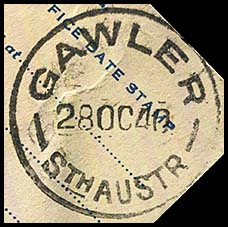 28 October 1940. Used on AB-DO-8H. |
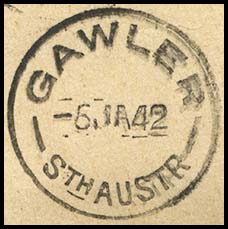 6 January 1942. Used on Christmas Greetings telegram AB-CXF-38Ca. |
SC1. Steel circular date stamp Has 7 mm side arcs
|
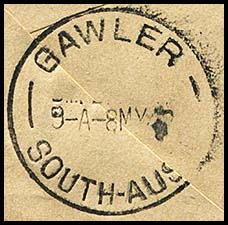 8 May 1940. Used on Mothers Day envelope AB-GME-39Bb. |
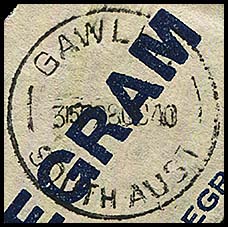 Used on window delivery envelope AB-EO-8. |
Telegraph Offices were also opened at:
|
||
|
A Telegraph Office was opened on 1 January 1870.
|
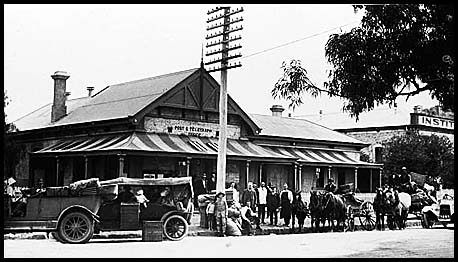 Hamley Bridge Post & Telegraph Station about 1921. Source: Trove/NLA B55150. |
|
The Kapunda Telegraph Station was opened on 11 May 1859. It had been planned to open on Friday 6 May. "Kapunda 12 May: The telegraph was successfully opened to the public yesterday, Mr. Todd having arrived the previous evening and found the circuit complete. The Hon. Captain Bagot and the member for Light, Mr. J. T. Bagot, arrived at noon, to assist in the opening ceremonies. The Station is opened temporarily at the Sir John Franklin Hotel and the spirited landlord had constructed festoons of gay streamers which flaunted across the road to the telegraph-post on the opposite side. (South Australian Advertiser (18 May 1859, p. 5)). |
 Main street of Kapunda about 1925. |
|
|
In the House of Assembly on 15 June 1859, the Commissioner of Public Works said the total receipts (at the Kapunda Telegraph Station) to date had been £17 1s. 6d. That was at the rate of £295 annually which would give a profit of £75 l9s. annually.
On 1 October 1959, the Adelaide Observer reported that the Post Office and Telegraph Station were about to be removed into a new cottage between the Bank and the old Post Office until the new building is completed. Apparently in about September-October the Post Office was moved to be in the same location as the Telegraph Office.
The South Australian Register of 3 January 1860 reported that a further £256/1/6 had been allocated to the Kapunda P&T Office for use before 15 February 1860. |
|
After only about three months of operation, the Telegraph Office played a supporting role when the Admella was wrecked nearby with heavy loss of life. The South Australian Advertiser of 24 August 1859 reported that:
The South Australian Advertiser of 5 November 1859 reported on another incident involving the Telegraph Office:
|
|
|
|
From 1 October 1859, Mr. Darwin had responsibility for both the Telegraph Office and the Post Office. By 1863, Mr Darwin was fully aware of the often incorrect complaints made by a minority of customers. In 1865, he was embroiled in an important legal discussion, also involving Charles Todd, about the legal status of telegrams and who was the actual custodian of them. Some time after, the South Australian Register reported, on 30 August 1865, that "Mr. V. H. Darwin, Postmaster and Telegraph Officer at Kapunda, met with a very serious accident on the 29th, by a fall from his horse. He was found near the main street in an unconscious state and bleeding profusely from the ears. The fall has occasioned concussion of the brain and it is feared more serious injury to the head". Mr Darwin clearly recuperated fully because, in the Kapunda Herald of 20 April 1866, there was a long editorial seeking mention of his good work and calling for "a really good capricious Post-Office, as well as a good telegraphic station, with an ample staff in each, but being quite independent one another (because) the postal and telegraphic services to and from Kapunda are both amongst the most remunerative of their kind and, with the prospects of a still further extension of trade, which has caused two additional Banks to be started there, it is morally certain that the business of these offices will continue steadily ...". On 29 June 1866, Mr Darwin was elected to Secretary of the Kapunda Institute. Amounts of £1,000 were placed on the estimates in 1866 and 1867 for the erection of a new Post and Telegraph Office. In July 1870, many people from the surrounding district attended the monthly sale. It was reported that "everyone was delighted to see the Post & Telegraph Office well-lit with gas for the first time". Presumably this building is the one shown above. |
|
|
The name Mallala is derived from the Kaurna language and means "place of the ground frog". After several years of requesting the Government for the provision of a Telegraph Office, the residents were becoming angry. The report of a public meeting on 18 June 1879 in the 24 June 1879 Yorke's Peninsula Advertiser stated the following:
On 13 January 1880, the South Australian Register noted that the residents of Mallala "have reason to believe that sooner or later they shall have a Post Office and Telegraph Station — not before it is wanted — although as yet there are no outward signs of its being carried into effect". The site for the new building was decided in mid February 1880. It was as near as possible to the centre of the business places in the township. The building had not started by April 1880. The importance of having the Telegraph Office is clearly understood when it is known that at that time residents had to ride a distance of twelve miles to send a message and they had to pay twelve shillings for having a message delivered to Mallala. On 12-13 May, 1880 the ketch Capella "discharged 350 telegraph poles at Wallaroo for the line between Mallala and Two Wells and she will return with the balance to complete the whole of the line ". On May 17, there was a "chance of telegraphic communication between here and Adelaide becoming a fact as today poles are being laid in the township". A temporary Telegraph Office was opened when the line was connected on 22 July 1880. The Adelaide Observer of 6 November 1880 observed "The new Post and Telegraph Office is finished and has been so for about a week. It is hoped that steps will be taken to have it opened for business at once. The postmistress has been obliged to put a notice on the window of the new building to prevent persons posting their letters there - one party having done so |
|
The Post and Telegraph Office opened on 27 August 1878. A contract had been let to Messrs. Fisher and Wright at Saddleworth in February 1878 for their lowest tender of £549 12s. In the Evening Journal of 28 November 1877: "The Telegraph Office at Marrabel would be opened as soon as the building for which provision had been made in the Estimates could be erected, that the building would be proceeded with when the Appropriation Bill was passed, and that it was reported to the Government that no temporary accommodation was available". |
|
On 12 March 1880, the Evening Journal reported on a visit to Penfield by the Minister of Education. Children at the local school had been given a half-day holiday.
Official records show that Penfield was never connected to the telegraph lines. |
|
The Telegraph Office was opened in 1861. The Post Office opened in 1862 at the Railway Station so the Station Master also performed the duties of Post Master. It is very probable that the Telegraph Office was also located at the Railway Station. |
|
|
The Telegraph Office opened in 1857 as the line was constructed through to Gawler. A post office was established at Salisbury in 1850 but closed at the end of 1851. It was reopened in 1854. |
|
|
This station was on the first line constructed through to Gawler from Adelaide in 1857. It may have served as a repeater station although it was only 19 miles from Adelaide. A Telegraph Station was constructed and opened in 1859. In 1858, the Post Office was opened through a change of name from Gawler Plains. The Adelaide Observer of 26 March 1859 published the following letter:
|
|
|
The Telegraph Office was opened to the public on 1 March 1882 at about 10 o'clock. Several of the leading residents assembled at the station by the kind invitation of Mr. F. Belcher, the postmaster and sat down to a very nice spread ..stockyards creek telegraph SA. |
|
|
In June 1881 there had been references to the residents of Stockyard Creek being very much in want of a telegraph line because the nearest office was eight miles away. A Telegraph Office was opened to the public at about 10 o'clock on 1 March 1882 "Several of the leading residents assembled at the station by the kind invitation of Mr. F. Belcher, the postmaster, and sat down to a very nice cold collation .... before leaving the dining-room the health of Mr. and Mrs. Belcher was drunk in bumpers for their kindness on the occasion after which an adjournment was made to the office and the usual congratulatory messages were sent and replies received". A Post Office had opened at Stockyard Creek on the Hamley Bridge and Balaklava Railway line on 28 April 1880. |
|
Tarlee (originally Forresters). The Telegraph Office was opened on 1 January 1870 |
|
|
The Post & Telegraph Office opened on 20 May 1880. On that day "the township was decorated with bunting, and a triumphal arch, bearing the words "Welcome to Teatree Gully" was erected across the main road, leading into the township ... the (telegraph) wires had run through the township but the difficulty of house accommodation stood in the way, and it was not until the Government purchased the old hotel on the hill that the difficulty was overcome ... (during the opening) The Post-Office clock was distinctly heard to strike, much to the astonishment of the residents". |
In August 1879, a Parliamentary delegation of 12 members inspected the building proposed for conversion into the new Post & Telegraph office. They had left Parliament House "in two traps" and arrived about two hours later. The building had previously been known as the Highercombe Hotel and it stood on the rise of a hill facing the East Torrens Road but a little way back. The Register noted that "It had been urged by some members that the building was totally unsuitable and was in a very ricketty tumble-down condition, and whispers that a job had been perpetrated were circulated freely amongst those disaffected towards the Government." The hotel stood on 1.5 acres and had originally cost between £3,000 and £4,000 to build. It was sold to the Government for £600. The delegation arrived to inspect inside the building but were told the key had been left in Adelaide:
Not all was smooth sailing for the people of Tea Tree Gully or the District of Gumeracha. In the House on 19 September 1879, Mr Rees spoke as follows:
|
|
The Evening Journal of 9 April 1870 reported the statement by Hon. J. Colton at an election meeting in the District of Stanley that he "would do all he could to get the telegraph lines to Two Wells". The Telegraph Office at Two Wells was opened on 16 December 1874. On 2 September 1876, the South Australian Chronicle reported part of a public meeting which requested that "Further accommodation at the Post and Telegraph Office at Two Wells was necessary and the necessity of a tramway from the township to Port Gawler for the conveyance of wheat was greatly felt". In the Adelaide Observer of 18 November 1876, it was noted that "The telegraph authorities have acceded to the request to remove the poles to the same side of the road as the Telegraph Station and Post Office. The removal of the offices to the new building is being carried on today". |
|
In the early 1850s, Virginia was a staging post for the Cobb & Co coaches. It took a day to travel between Virginia and Adelaide. A Post Office was opened in 1858 and also a small shop. On 24 June 1876, the Adelaide Observer noted that "It is to be hoped that the present Ministry will see the need of granting us telegraphic communication with the rest of the Colony. It comes very hard on struggling men to pay 10 shillings for a message but such has been the case here several times". In the House of 23 August 1876, Mr Bower moved that "He believed that the persons resident at Virginia had a right to such communication, because the nearest telegraph office at Two Wells was six miles distant. Virginia was a place of some importance, and was centrally situated; and as the telegraph line went through the township, the only requisite was an operator, who could carry on the work in one of the stores". Mr. Cowan agreed and said that he had information about a person in the town who was competent to operate the machinery and who would do so for a nominal sum. The Minister of Agriculture and Education noted that revenue from such an office would not exceed £40 per year and the cost of an operator would be £80 plus £500 for an Office. If however a building could be found for a nominal price, perhaps the question could be brought back to the House. In discussion in the House on 2 November 1876, The Minister of Agriculture and Education replied to a question: "if an offer were submitted from a person whose name has been mentioned at Virginia to conduct the Telegraph Office, it would be accepted". |
|
Virginia squared circle date stamp. Number in the Census used on a telegram: 0 |
 20 July 1905. Postally used. |
|
The Telegraph Office opened on 1 January 1870. A Post Office had opened in July 1869. |
|
| Standard steel circular postal date stamp. | 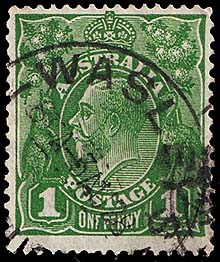 Wasleys 3 August 1928. |


